

- #Digital forensics procedures windows vs linux mac os how to#
- #Digital forensics procedures windows vs linux mac os software#
- #Digital forensics procedures windows vs linux mac os free#
If hardware or software RAID 5 is employed, a volume consists of stripes spanning multiple disks. A volume can be all or a portion of a single disk or it can extend across multiple disks. At any time, a volume consists of a file system information, a collection of files, and any additional unallocated space remaining on the volume that can be allocated to files. The cluster size in sectors is a power of 2.Ī logical partition on a disk, consisting of one or more clusters and used by a file system to allocate space. One or more contiguous (next to each other on the same track) sectors. The data size in bytes is a power of 2 and is almost always 512 bytes. The smallest physical storage unit on the disk. NTFS makes use of the following disk storage concepts. The most notable features of NTFS include the following. NTFS is a flexible and powerful file system, built on a simple file system model. Network applications for large corporate systems.Resource-intensive engineering and scientific applications.Client/server applications such as file servers, computer servers and database servers.But the developers of also designed a new file system, the W2K file system (NTFS), that is intended to meet high-end requirements for workstations and servers.Įxamples of high-end applications include the following. Named pipe – This is a common channel between two or more processes for data exchange.įile System in Windows :- Windows 2000 (W2K) supports a number of file systems including the file allocation table (FAT) that runs on Windows 95, MS-DOS and OS/2.Special File – This refers to a device driver.Symbolic Link – This file is actually a link to (or path of) another file.Ordinary File – This is a file containing data or application program or executable.Directory – This is simply a list of names.I-nodes – These are the actual i-nodes.
#Digital forensics procedures windows vs linux mac os free#

Super Block – Specifies the number of blocks, the number of i-nodes, block size etc.Program for Shortest Job First (or SJF) CPU Scheduling | Set 1 (Non- preemptive).Preemptive and Non-Preemptive Scheduling.Introduction of Process Synchronization.Commonly Asked Operating Systems Interview Questions.Random Access Memory (RAM) and Read Only Memory (ROM).Program for Round Robin scheduling | Set 1.Introduction of Operating System - Set 1.Program for FCFS CPU Scheduling | Set 1.Introduction of Deadlock in Operating System.Page Replacement Algorithms in Operating Systems.ISRO CS Syllabus for Scientist/Engineer Exam.ISRO CS Original Papers and Official Keys.

#Digital forensics procedures windows vs linux mac os how to#
Mobile operating systems such as Android, iOS, Windows, and Blackberry are also covered, providing everything practitioners need to conduct a forensic investigation of the most commonly used operating systems, including technical details of how each operating system works and how to find artifacts. In this article we will consider two key points of forensic analysis of such devices: 1) Extracting data from Apple mobile devices 2) Forensic analysis. Therefore, it is often on research in forensic laboratories. Mobile devices of Apple such as iPhones and iPads are 15 of the mobile market. Users will learn how to conduct successful digital forensic examinations in Windows, Linux, and Mac OS, the methodologies used, key technical concepts, and the tools needed to perform examinations. Acquisition and Forensic Analysis of Apple Devices. Operating System Forensics is the first book to cover all three critical operating systems for digital forensic investigations in one comprehensive reference.


 0 kommentar(er)
0 kommentar(er)
